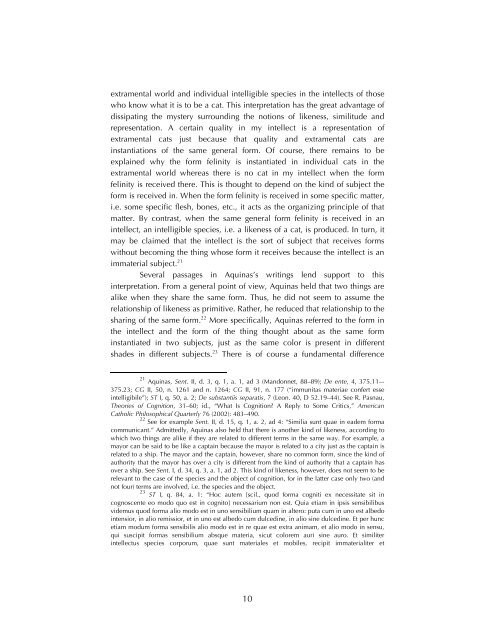Two Models of Thinking - Fordham University Faculty
Two Models of Thinking - Fordham University Faculty
Two Models of Thinking - Fordham University Faculty
You also want an ePaper? Increase the reach of your titles
YUMPU automatically turns print PDFs into web optimized ePapers that Google loves.
extramental world and individual intelligible species in the intellects <strong>of</strong> thosewho know what it is to be a cat. This interpretation has the great advantage <strong>of</strong>dissipating the mystery surrounding the notions <strong>of</strong> likeness, similitude andrepresentation. A certain quality in my intellect is a representation <strong>of</strong>extramental cats just because that quality and extramental cats areinstantiations <strong>of</strong> the same general form. Of course, there remains to beexplained why the form felinity is instantiated in individual cats in theextramental world whereas there is no cat in my intellect when the formfelinity is received there. This is thought to depend on the kind <strong>of</strong> subject theform is received in. When the form felinity is received in some specific matter,i.e. some specific flesh, bones, etc., it acts as the organizing principle <strong>of</strong> thatmatter. By contrast, when the same general form felinity is received in anintellect, an intelligible species, i.e. a likeness <strong>of</strong> a cat, is produced. In turn, itmay be claimed that the intellect is the sort <strong>of</strong> subject that receives formswithout becoming the thing whose form it receives because the intellect is animmaterial subject. 21Several passages in Aquinas’s writings lend support to thisinterpretation. From a general point <strong>of</strong> view, Aquinas held that two things arealike when they share the same form. Thus, he did not seem to assume therelationship <strong>of</strong> likeness as primitive. Rather, he reduced that relationship to thesharing <strong>of</strong> the same form. 22 More specifically, Aquinas referred to the form inthe intellect and the form <strong>of</strong> the thing thought about as the same forminstantiated in two subjects, just as the same color is present in differentshades in different subjects. 23 There is <strong>of</strong> course a fundamental difference21 Aquinas, Sent. II, d. 3, q. 1, a. 1, ad 3 (Mandonnet, 88–89); De ente, 4, 375.11–-375.23; CG II, 50, n. 1261 and n. 1264; CG II, 91, n. 177 (“immunitas materiae confert esseintelligibile”); ST I, q. 50, a. 2; De substantiis separatis, 7 (Leon. 40, D 52.19–44). See R. Pasnau,Theories <strong>of</strong> Cognition, 31–60; id., “What Is Cognition? A Reply to Some Critics,” AmericanCatholic Philosophical Quarterly 76 (2002): 483–490.22 See for example Sent. II, d. 15, q. 1, a. 2, ad 4: “Similia sunt quae in eadem formacommunicant.” Admittedly, Aquinas also held that there is another kind <strong>of</strong> likeness, according towhich two things are alike if they are related to different terms in the same way. For example, amayor can be said to be like a captain because the mayor is related to a city just as the captain isrelated to a ship. The mayor and the captain, however, share no common form, since the kind <strong>of</strong>authority that the mayor has over a city is different from the kind <strong>of</strong> authority that a captain hasover a ship. See Sent. I, d. 34, q. 3, a. 1, ad 2. This kind <strong>of</strong> likeness, however, does not seem to berelevant to the case <strong>of</strong> the species and the object <strong>of</strong> cognition, for in the latter case only two (andnot four) terms are involved, i.e. the species and the object.23 ST I, q. 84, a. 1: “Hoc autem [scil., quod forma cogniti ex necessitate sit incognoscente eo modo quo est in cognito] necessarium non est. Quia etiam in ipsis sensibilibusvidemus quod forma alio modo est in uno sensibilium quam in altero: puta cum in uno est albedointensior, in alio remissior, et in uno est albedo cum dulcedine, in alio sine dulcedine. Et per huncetiam modum forma sensibilis alio modo est in re quae est extra animam, et alio modo in sensu,qui suscipit formas sensibilium absque materia, sicut colorem auri sine auro. Et similiterintellectus species corporum, quae sunt materiales et mobiles, recipit immaterialiter et10
















